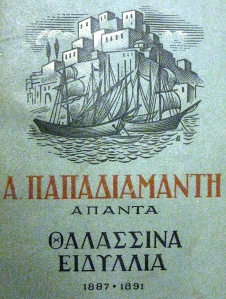Our department, Collections and Academic Liaison, works on the lion’s share of donations of books made to the University Library. Since our numbers in the library building have had to be kept very low since mid-March last year, our focus in the office has chiefly been on cataloguing new bought books, but this post mentions a few donations that we have been able to process recently. Continue reading “Some lockdown-era donations”
Category: Modern Greek
Greek diglossia and the “language question” through history and literature
This post will delve into the evolution of diglossia in the Greek language, the use of two very different forms of the same language for different purposes. This is a phenomenon that has its roots in Ancient Greece (800 B.C. to 500 B.C) and grew in form during the Byzantine Empire (395 A.D. to 1453). An increased gap between spoken and written Greek developed over time because of this phenomenon and raised the “language question” of what form of Greek the Greek people should use. The dichotomy between the two evolutions of the Greek language is a result of the distinction between educated readers and the general public, the foreign influences that made the language adapt, clinging to the glory of the Ancient Greek past, and the language being directly related to Christianity and social reformation.
Oral tradition was the main form of Ancient Greek expression and it was only later on that works of literature such as Homer were written down. The predominant dialects of the time were Attic (central Greece) and Ionic (outskirts and islands) which gradually evolved into “Koine” (common, shared). Koine Greek, also known as Alexandrian dialect, or common Attic, was the common supra-regional form of Greek spoken and written during the Hellenistic period, the Roman Empire, and the early Byzantine Empire, or late antiquity. It spread to massive proportions under Alexander the Great, as it was adapted as a second language by most of the ancient world during his reign. This was the first step towards dichotomy as educated readers longed for the classical period and an Attic dialect more closely related to Ancient Greek.
Continue reading “Greek diglossia and the “language question” through history and literature”
Modern Greek in the University Library

The University Library’s Modern Greek collection, which numbers over 13,000 items, is now represented on the Library’s language-specific webpages. An introduction to the collection, with an explanation about transliteration and a guide to history and literature classmarks, has been put up on this page. The text of that page is provided in this blog post.
The Modern Greek collection
The University Library has got over 13,000 items in Modern Greek in the electronic catalogue, stretching from the 16th century to the current day. The 16th to 18th centuries are represented by over 400 books in total, and then the 19th century sees a leap up to over 1,000 items. A greater leap still follows for the 20th century, with over 8,500. The 21st century is so far represented by nearly 3,000 books.

